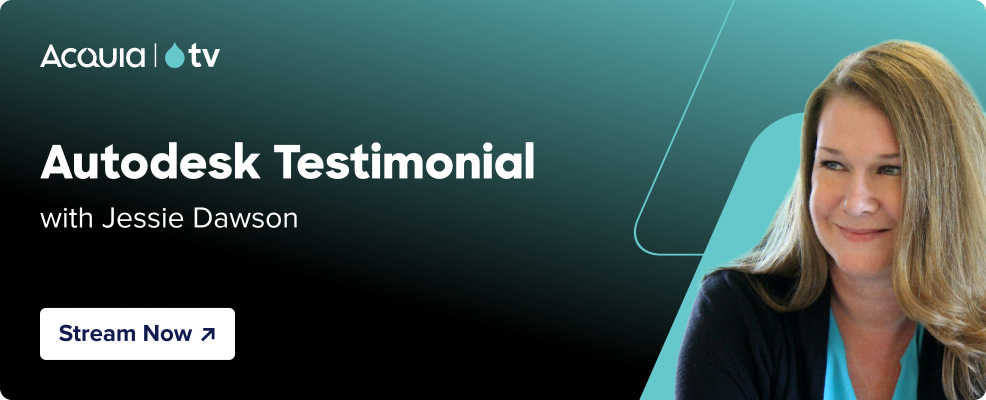Brand Relaunch 101: Creating a Successful Brand Rollout Plan

Danielle Templeton
Creative Manager, Acquia
Every brand evolves over time. One day, your brand will outgrow the look and feel you’ve used for years. The audience you speak to will change their behaviors. Your purpose will take on new meaning. And eventually, you’ll need to redesign the look and feel that worked so well and relaunch your brand.
Just the idea of relaunching all your newly designed brand assets can feel overwhelming. How are you possibly going to coordinate all the changes and updates? Don’t worry — with the right tools and strategic approach, any brand can roll out new assets at a global scale.
That doesn’t mean it’s easy to do. But if energy company Phillips 66 can implement brand guidelines to convey a clear corporate identity, you can redesign and relaunch your brand. First, let’s start by defining what a brand relaunch means in this context.
What is a brand relaunch?
Typically, a brand relaunch impacts many of the elements in your brand identity kit including visual style, logos, color profiles, and more. A relaunch can vary to include a full redesign, strategic updates, or a simple refresh.
Tips for a successful brand relaunch
Whether you’re looking at a full redesign or just a refresh, determining how to relaunch a brand should be your first step. Your brand relaunch needs to be deliberate and strategic. It includes a lot of planning before you even get to the exciting visual elements.
This is your new look we’re talking about, and changing it isn’t as easy as running to the store. So go into it with a well-constructed plan that will help you meet your goals and long-term objectives.
1. Define your “why”
Before making any public-facing changes, you must first understand the essence of why you're relaunching the brand. Common catalysts include mergers, acquisitions, outdated branding, or company expansion.
But your “why” is more about what you’re trying to achieve. Think: gaining a stronger foothold in your market, differentiating your brand from the competition, or successfully launching a new product. Understanding your “why” will make it easier to measure and celebrate your achievement because you’ll know what success looks like.
2. Understand the full picture
The way you view your brand internally might not match how external audiences perceive it. When gathering the full picture, tap your entire audience including current employees, potential employees, customers, future customers, and anyone who comes in contact with your brand.
Take time to understand multiple perspectives. Conduct internal and external interviews. Do competitive research. Use surveys. And understand the potential future of your market space. Determining how your brand is currently perceived can help further define the goals of your brand relaunch. This gives you evidence to refer to during the planning process, making it easier to compare where you are with where you want to be.
3. Obtain buy-in from internal stakeholders
Buy-in from company leaders is critical. The scope of a brand relaunch can creep quickly, and you’ll need internal teams in your corner when they do. Effectively communicating the reasons for a brand relaunch — and the desired outcomes — will go far in getting everyone on board.
Doing so will allow you to secure the time, resources, and talent needed to execute a successful relaunch. And keeping everyone in the loop throughout the process will encourage excitement while managing expectations.
4. Get emotional
Many elements of your brand aren’t tangible. They’re felt. The more your audience connects with your brand, the better. Emotions drive purchasing decisions. They foster relationships. And ultimately, emotional investment builds brand loyalty.
A brand relaunch should take this into consideration during the planning phases. Consider testing different versions and iterations of your brand prototypes before finalizing your decision. A relaunch is a perfect opportunity to increase the emotional connection with your brand.
5. Phased rollout or flip of the switch?
Depending on the size of your relaunch, you’ll need to consider how to release it into the world with a brand rollout plan. A phased rollout means that you can release your new creations into the world more quickly as each element is created, which also means you'll have two brands for the duration of the project.
If you choose to release the new brand all at once, you may have to duplicate work. While the new brand is created, the old one must be actively maintained, because it can't remain static as the new one is built, which could strain resources. Make sure to weigh the pros and cons of all rollout approaches and pick the one that works best for you. Don’t forget to communicate the plan as well so that people know what to expect.
6. Be realistic about timing
A rebranding signifies change in your organization, and change takes time. You need to dedicate enough time and resources to rebrand well so that your audience notices the difference. A full brand relaunch — including visual expression, value messaging, and more — can easily last a year or longer.
Underestimating the lead time for a project this size will often cause frustration, missed opportunities, and poor quality results. Being upfront and realistic with your stakeholders and mapping your project out by phases will keep things running smoothly and ensure a successful end result.
Essential brand relaunch strategies for your website
Good marketing is about forming relationships with customers and telling meaningful, memorable stories. The marketing process is ever-evolving so the motivation for change can vary. Spend time at CMO-focused events and you’ll likely hear leaders cite everything from a content or technology refresh to a merger with another company as motivation for a brand relaunch.
With the average tenure of a CMO around 14 months, leaders know they need to act fast to establish a strong presence and purpose for their brand. To keep up with the pace of innovation, digital leaders need to regularly refresh their brand every few years. A website refresh is a quintessential way to showcase this new vision or to carve out a space for a brand as the leader of a new category or a trailblazer in its industry.
Reimagine content for the researcher, not the buyer
Back in the mid-2000s, websites mainly acted as a way to convert leads, drive event registrations, and gather email addresses. These transaction-based relationships are no longer a brand’s primary digital focus. With the shift to a customer-experience mindset and the ongoing decline of third-party data tactics, marketers have shifted their perspective. Instead of approaching a website in terms of what a business wants someone to do, brands need to first think of what they can do to help someone who comes to the website.
With people spending more time browsing and consuming content online than ever before, relevant educational content — such as how-to pages, industry thought leadership, product comparisons, and instructional videos — is critical to teaching a potential new customer who your brand is and what you do. With so many different options available to them, today’s customers will only stick with a brand that offers them unique value and clearly and concisely explains why they're best suited to solve their problems.
One way to do this is to lead with content that immediately gets to the point of what potential customers want to know. For example, many CMOs evaluating a potential technology vendor are less interested in hearing a product pitch and more interested in seeing success stories and examples — like a look at current customers and the return on investment (ROI) they’ve attained. Additionally, CMOs value product comparisons against competitors; often, case studies and industry analyst reports provide this information.
CEOs are also very motivated by results. They don’t want to have to search through pages of marketing jargon to see if your product can save them money. So it’s important to prioritize content that clearly illustrates the ROI other customers have achieved. Thinking of a website in terms of data storytelling and combining hard pricing and revenue-focused information with a mix of content resources and visuals creates a richer, more purpose-driven experience for each customer persona.
Craft a clear, concise brand story
The best storytellers of all time know how to leave an impression in just a few, well-chosen words. And a brand’s website is one way of sharing that story. It’s the entryway for customers to learn more about offerings and services, but when people move between multiple channels and devices, you only have a few moments to capture their interest. So it’s beneficial to build a user experience that’s easy to navigate and offers clear definitions and descriptions of products without unnecessary barriers.
Straightforward communication is especially important for companies that are creating and defining new categories in their market. Being proactive in building content that speaks to the company’s vision ensures that all new content and product information produces a complete, connected brand image.
Choose innovative technology solutions to drive impact
A brand relaunch is also a perfect opportunity to review workflows and processes. Take a look at your marketing technology (martech) stack and identify tools that can be optimized, updated, consolidated, or integrated.
For instance, content management systems (CMSs) have advanced rapidly, and you may want to upgrade yours, perhaps with one that can support hybrid or headless architectures to allow content to be published to any digital channel. Because you can apply an API-first approach to a headless or hybrid CMS, teams can rebuild the front end of their websites without razing the entire site during a rebrand. The decoupled back end can transfer content via API to whatever front end needs to be displayed.
In other cases, you may be interested in exploring newer technologies that are quickly becoming de rigeur, such as a customer data platform (CDP). CDPs help organizations personalize outreach, so that product and service recommendations arrive at the exact right time in the customer journey and in the channel and with the message that most resonates with the customer. Powered by real-time analytics that unify and evaluate multiple customer data points, this capability can help during a rebrand when organizations may be looking to revive their reputation. For example, a brand that may have become known for poor customer service can turn that reputation on its head by consistently showing up for audiences with the content, offers, or solutions they seek and in the channels that most engage them. Each touchpoint also presents an opportunity to introduce the brand’s visual and tonal makeover.
Integrating technologies is another way brands realize impact. Teams invest in tools for specific functions, but when those tools work in silos, they’re less effective. Integrating tools so they work together and keep teams in the systems they’re used to enhances brand consistency and reduces time spent switching between systems.
The important thing is to find ways to leverage technology to streamline workflows so that teams can spend more time doing meaningful work versus spending time on tasks that could be automated.
Benefits of launching a new brand
Relaunching your brand is exciting. You’ll be proud to see months (and possibly years) of hard work all come together to achieve your goals. And the thrill of seeing your sharp new logo or updated visuals out in the world is just the icing on the cake. A meticulously planned and well-executed relaunch will create a wide range of benefits for your company, including:
- Alignment of brand elements across all channels to ensure they meet the needs and interests of your audience
- Improvement in the quality of internal communications as a result of brand education and awareness
- Elevated positioning amongst new and existing competitors in your industry
- New or renewed interest within your target audience
- Increased overall conversion opportunities and brand loyalty
And if you make brand consistency one of your main priorities, your brand relaunch can lead to an increase in revenue of up to 23%. It won’t happen overnight, and it’ll take a serious commitment to brand management to get there, but it’s worth it. With the right brand management software, like a digital asset management (DAM) system, you can also protect your brand from unnecessary risk.
So, are you a little less overwhelmed than when you first started thinking about launching all your new brand assets? We hope so. With the right approach and technology to back you up, you can actually look forward to your brand relaunch.
Get excited about your brand relaunch
Your brand will evolve and need a facelift one day. There’s no way around it. So you might as well look at relaunching your brand as an adventure. It’s not only a way to meet new goals but also to stretch your creative muscles and get teams to unite behind a common goal.
And while they can be daunting, successful launches are invigorating and inspiring. So take the time to effectively research, plan, and communicate your process. It will keep your adventure on track and make it much more rewarding when your efforts are ready to be seen by all.
Your relaunch could include a new logo, all your brand assets, or a whole new story and visual design for your brand. Whatever the scale, you need to make sure all your brand assets are secure, centralized, and searchable.
With Acquia DAM as your brand management software, you have a strong foundation to help share your new brand experience with the world. Get your free trial today to see how brand management software can support your brand relaunch. Or, get in touch with our Advisor team for a personalized demo.



